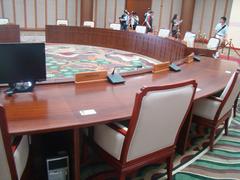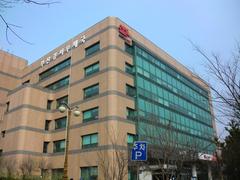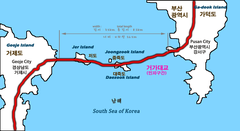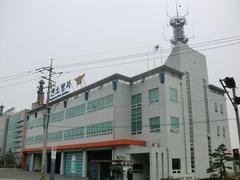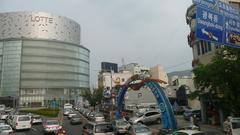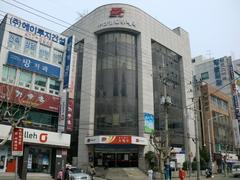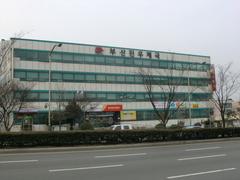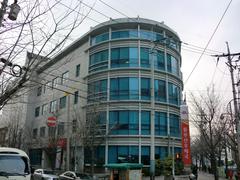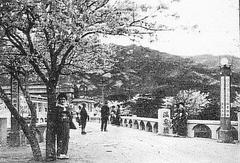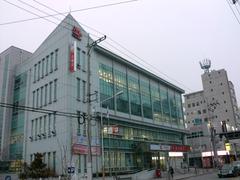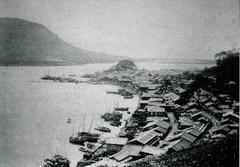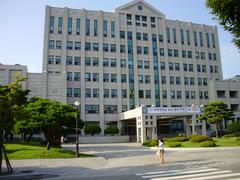Busanjin Station Visiting Hours, Tickets, and Travel Guide: Exploring Busan’s Historical Sites
Date: 04/07/2025
Introduction: History and Significance of Busanjin Station
Busanjin Station, centrally located in Busan’s Busanjin-gu district, is a distinguished landmark that encapsulates both the historical evolution and the modern vibrancy of South Korea’s second-largest city. Opened in 1943 during the Japanese colonial period as part of the Gyeongbu Line, it played a crucial role during pivotal moments such as the Korean War, serving as a vital conduit for refugees and supplies. This enduring presence has left an indelible mark on Busan’s urban identity, witnessing its transformation from a regional port to a bustling metropolis (Trip.com).
In recent years, Busanjin Station has undergone significant revitalization. In 2024, the historic station building was repurposed as the “In and Out” children’s cultural facility, seamlessly combining heritage preservation with innovative urban regeneration. This adaptive reuse stands as a testament to Busan’s commitment to fostering community engagement and cultural enrichment (Haps Korea). Simultaneously, the station remains a key node in Busan’s transport network, interconnected with Seomyeon Metro Station, major bus routes, and providing easy access to popular districts like Seomyeon, Jeonpo Café Street, and Bujeon Market (The Broke Backpacker).
Historical Development and Transformation
From Railway Hub to Urban Landmark
Busanjin Station’s establishment in 1943 was instrumental to the rapid industrialization and urbanization of Busan. During the Korean War (1950–1953), the station became a lifeline for millions seeking refuge, catalyzing the growth of surrounding neighborhoods and markets.
Following the war, the station supported Busan’s economic boom, contributing to the densification and commercialization of the Busanjin-gu district. The opening of the new Busan Station (KTX) in 2004 shifted much of the long-distance traffic, but Busanjin Station adapted by embracing urban regeneration initiatives (Trip.com).
Urban Regeneration and the “In and Out” Cultural Facility
A milestone in Busanjin Station’s modern history was the 2024 transformation of its historic building into the “In and Out” children’s cultural facility. As part of Busan’s broader urban renewal strategy, this facility offers interactive educational programs and creative spaces, free to the public, symbolizing Busan’s innovative approach to cultural policy (Haps Korea).
Essential Visitor Information
Visiting Hours
-
“In and Out” Cultural Facility:
Open Tuesday–Sunday, 10:00 AM–6:00 PM.
Closed Mondays and public holidays.
Check official sources for changes during events or holidays. -
Train Station Operations:
Approximately 5:00 AM–11:30 PM daily.
Ticket counters usually open from 5:30 AM until the last departure.
Tickets and Entry Fees
-
“In and Out” Facility:
Free general admission; some special programs may require advance registration or a nominal fee. -
Train Tickets:
Available at staffed counters, automated kiosks, or online via KORAIL.
Integrated transit cards (T-money, Hanaro, Cashbee) are accepted and recommended for convenience (The Broke Backpacker).
Accessibility
Busanjin Station and its facilities are fully accessible, offering ramps, elevators, tactile paving, and accessible restrooms to ensure comfort for all visitors.
Getting There
- By Metro:
Short walk from Seomyeon Station (Lines 1 & 2) or Bujeon Station (Line 1). - By Bus:
Numerous city routes serve the station area. - From Gimhae International Airport:
Take Metro Line 2 to Seomyeon Station. - Tip:
Public transport is recommended due to limited parking (Traveloka).
Station Facilities and Services
- Climate-controlled waiting areas
- Clean restrooms and accessible amenities
- Multilingual information desks
- Coin-operated lockers for luggage storage
- Retail outlets, cafés, convenience stores, and vending machines
- Free Wi-Fi and charging stations
Significance in Busan’s Urban Landscape
Transportation Nexus
Busanjin Station is integral to Busan’s transit system, offering easy connections to metro lines, bus routes, and intercity trains. Its central location makes it a strategic base for exploring nearby districts (KoreaToDo).
Catalyst for Commerce and Culture
The station’s presence spurred the development of Seomyeon, Busan’s premier shopping and entertainment district. Its transformation into a cultural facility further diversifies the area’s appeal, attracting families and fostering community engagement (Trip.com).
Urban Renewal and Inclusivity
Busanjin Station is at the heart of efforts to counteract urban polarization and promote balanced growth in Busan. The redevelopment of the station and surrounding spaces aims to create inclusive, pedestrian-friendly environments (Breeze in Busan).
Busanjin–Busan Station Underground Railway Project
A transformative urban initiative, the Busanjin–Busan Station Underground Railway Project will relocate a 2.8 km section of the Gyeongbu Line underground. The project aims to reclaim surface land for new parks, plazas, and commercial development, enhancing urban connectivity and public space (Breeze in Busan).
- Construction Impact:
Temporary changes in access and routes are possible—follow posted signs and staff instructions. - Completion Timeline:
Basic plan by mid-2025; further details to be announced.
Exploring Nearby Attractions
Historical and Cultural Sites
- Busan Citizens Park: Urban park with themed gardens and history displays.
- Busan Modern History Museum: Exhibits on Busan’s transformation and history.
- Bokcheon Museum: Artifacts from the ancient Gaya Confederacy.
Shopping and Culinary Hotspots
- Seomyeon Shopping District: Underground mall, Lotte Department Store, boutiques.
- Bujeon Market: Traditional market with fresh produce and street food.
- Jeonpo Café Street: Trendy cafés and bakeries.
- Local Cuisine: Try Busan’s specialties like milmyeon (wheat noodles) and dwaeji gukbap (pork soup rice).
Amenities and Accommodation
- Variety of hotels and guesthouses, from budget to luxury.
- ATMs, currency exchange, tourist information centers, and free Wi-Fi onsite.
Practical Travel Tips
- Language:
English signage is limited—carry addresses in Korean or use a translation app. - Payment:
Credit cards and cash are widely accepted; use transportation cards for convenience. - Luggage:
Lockers available for temporary storage. - Peak Hours:
Rush hours are 7:00–9:00 AM and 5:00–7:00 PM. - Safety:
CCTV-monitored, secure environment—stay alert for personal belongings.
Frequently Asked Questions (FAQs)
Q: What are the current visiting hours for the “In and Out” cultural facility at Busanjin Station?
A: Tuesday–Sunday, 10:00 AM–6:00 PM; closed Mondays and holidays.
Q: Are there entry fees?
A: General admission is free; some programs may have a small fee.
Q: How do I buy train tickets?
A: At station counters, kiosks, or online via KORAIL. Use transit cards for added convenience.
Q: Is the station accessible for people with disabilities?
A: Yes, accessibility features are available throughout the facility.
Q: What are the best nearby attractions?
A: Seomyeon Shopping District, Bujeon Market, Busan Citizens Park, and several museums are all close by.
Q: How will the underground railway project affect my visit?
A: Minor detours and temporary changes may occur. Check official updates before your trip.
Visual Guide and Maps
For interactive maps and images of Busanjin Station and nearby attractions, visit the KORAIL website, Busan Metro site, and the official Busan tourism website.
Final Tips and Resources
- Download the Audiala app for real-time schedules, personalized travel tips, and exclusive offers.
- For up-to-date events and information, consult the Busan Metropolitan City events page.
- Follow Busan tourism and Audiala on social media for current news and deals.
Summary
Busanjin Station is a dynamic symbol of Busan’s historical depth, resilience, and forward-looking spirit. Its transformation from a wartime lifeline to a vibrant cultural and transportation hub reflects the city’s commitment to inclusive urban development and heritage preservation. With convenient transport links, modern facilities, and proximity to shopping, cultural sites, and culinary experiences, Busanjin Station is an ideal gateway for discovering Busan’s rich past and dynamic present (Trip.com; Haps Korea; The Broke Backpacker; KoreaToDo; Breeze in Busan; Traveloka).
Official Resources and Further Reading
- Trip.com: Busanjin Station Busan - Visiting Hours, Tickets, History & Travel Tips
- Haps Korea: Old Busanjin Station Reopens as Children’s Cultural Facility
- The Broke Backpacker: Busanjin Station Guide
- Breeze in Busan: Busanjin Station Underground Project
- KoreaToDo: Busanjin Station Travel Guide
- Traveloka: Busanjin Station Information

